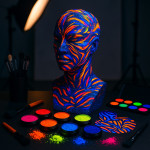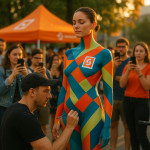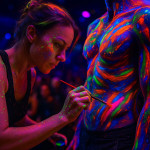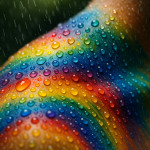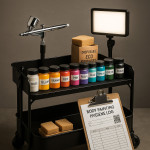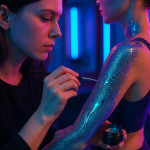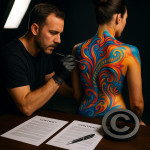UV-reactive pigments: safety rules every body-painting maquilleur abides by
UV-reactive pigments unlock breathtaking looks under black light, yet they demand rigorous safety protocols. In this guide, you'll learn how professional body-painting maquilleurs select compliant products, prep skin, control workspace hygiene and protect models before, during and after each luminous session.
Why UV-reactive pigments behave differently on skin
Fluorescence versus phosphorescence
Most cosmetic neon paints are fluorescent: they absorb invisible ultraviolet rays and instantly re-emit visible light. Phosphorescent products store energy and glow even after the UV lamp switches off. Because fluorescence happens in real time, pigments must sit in a thin, even layer; any clumping can overheat or irritate skin under prolonged UV exposure.
Particle size and skin penetration
To guarantee brilliance, manufacturers mill fluorescent particles to 5–10 µm. At this size, they remain on the stratum corneum rather than entering deeper layers—provided heavy metals and nanoparticles are excluded. Certified maquilleurs always cross-check Safety Data Sheets (SDS) for particle distribution before buying new colours.
Seven non-negotiable safety rules professionals live by
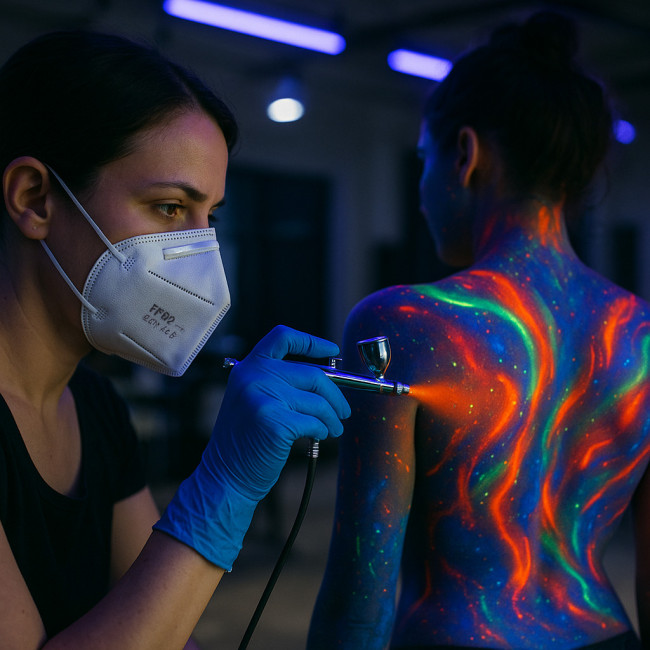
From patch tests to post-session documentation, these guidelines exist not to slow creativity but to guarantee every neon shoot ends without redness, coughing or legal headaches. Regulatory agencies perform surprise inspections at festivals, and industry insurers now require written SOPs plus pigment invoices before underwriting an event. A maquilleur who ignores the fundamentals below quickly becomes unbookable, so mastering them is as vital as blending flawless gradients.
- Rule 1 – Buy EU/FDA cosmetic-grade pigments only. Art-supply “neon paints” may contain solvent dyes or formaldehyde releasers. Verify EU Regulation 1223/2009 or FDA CFR Title 21 part numbers on the label.
- Rule 2 – Patch-test every client. Apply a 1 cm² dot inside the elbow 24 hours before the shoot. No redness, no swelling ⇒ clearance to proceed.
- Rule 3 – Keep UV lamp distance above 50 cm. This minimises skin temperature rise and eye strain.
- Rule 4 – Ventilate and wear a respirator during airbrush work. Even cosmetic pigments can irritate lungs when airborne.
- Rule 5 – Never paint over compromised skin. Cuts, eczema or recent waxing increase absorption risk.
- Rule 6 – Remove paint with pH-neutral cleansers. Vigorous scrubbing can drive residual pigment into pores.
- Rule 7 – Document every batch code. If a reaction occurs, traceability speeds up medical advice and product recall.
Ingredient red flags and legal thresholds
| Substance | EU max. level (ppm) | Risk if exceeded |
|---|---|---|
| Lead | 20 | Neurotoxicity, cumulative poisoning |
| Arsenic | 5 | Carcinogenicity |
| Cadmium | 5 | Kidney damage |
| Nickel | 200 | Severe contact dermatitis |
| Mercury | 1 | Systemic toxicity |
Numbers stem from Annex II of EU Regulation 1223/2009 and the Safety Gate rapid-alert portal. Reliable brands publish third-party lab results proving these thresholds aren't crossed.
Source : EU Safety Gate
Decontamination workflow after the show
- Switch off UV lamps and let skin temperature normalise for 5 minutes.
- Apply micellar water with lint-free pads; hold for 10 seconds, then wipe.
- Emulsify residue using a sulphate-free shower gel; rinse with lukewarm water.
- Spritz thermal water to rebalance pH and soothe redness.
- Record any irritation in the client file and photograph affected areas under daylight.
Practical tips for live events
Body paint often pairs with tight schedules and stage lighting. Professionals therefore:
- Carry a lux meter to adjust UV bulb placement and avoid over-illumination of sensitive zones.
- Use non-latex disposable sponges; latex glows under UV and can contaminate colours.
- Keep a dedicated “spill kit” with microfibre cloths, isopropyl alcohol (70 %) and nitrile gloves for quick slate or floor clean-ups.
- Offer models UV-blocking safety glasses between takes—especially children.
Need more on timing and pricing? Our piece on decoding body-painting day rates breaks down budget planning.
QUIZ – Are your neon paints truly skin-safe?
Expand your neon skill set
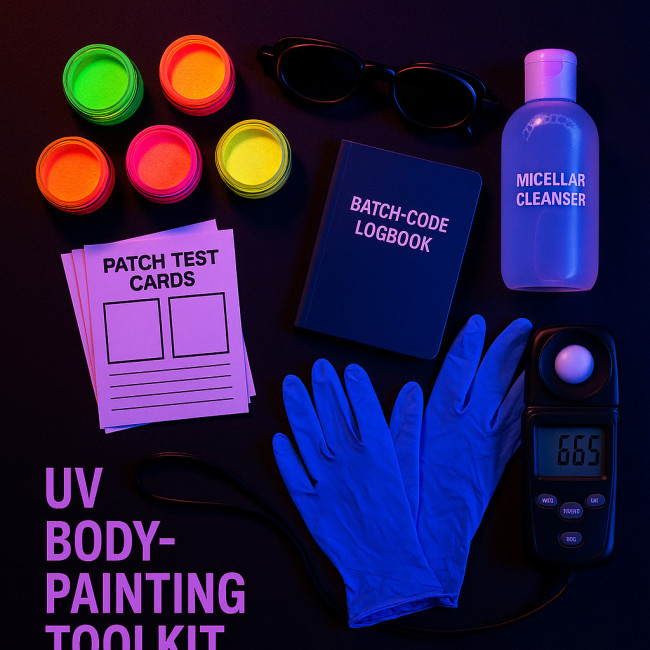
If UV gigs form part of broader brand activations, read our guide on booking a standout body-painting maquilleur for activations. Need ultra-fast talent? Scout a maquilleur in 48 hours details proven search shortcuts. For outdoor festivals, don't miss water-proofing techniques that keep neon art intact. Although each commission differs in scope, the planning thread that links them all is a razor-sharp attention to regulatory compliance, logistics, lighting and timing—a combination that can make or break the overall audience experience.
Finally, discover seasoned professionals in the professional body-painting maquilleurs directory and secure compliant talent for your next UV spectacle.
FAQ
- Can I use craft-store neon paint on skin if I add a barrier spray?
- No. Barrier sprays prevent smudging, not chemical absorption. Only cosmetic-grade UV-reactive pigments are designed for dermal contact.
- How long can a model stay under black light safely?
- With a 365–405 nm lamp placed 50 cm away and ambient room temperature, sessions of 15 minutes followed by 5-minute breaks are considered safe for adults with healthy skin.
- Do fluorescent pigments expire faster than regular paints?
- Yes. Fluorescent dyes degrade with light exposure. Store bottles in opaque containers and discard after 12 months once opened.
- Is UV body paint safe for pregnant models?
- Most regulations lack specific pregnancy data. Responsible maquilleurs advise patch-testing and obtaining medical clearance before proceeding.
